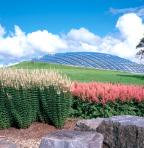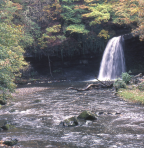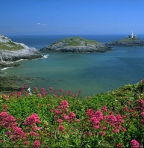
Swansea
Liberty Stadium. Home of Swansea City
Waterfront
Oystermouth Castle
National Botanical Gardens
Vale of Neath
Gower Peninsular
CITY
Introduction:
Swansea is a city on the south coast of Wales. Sitting on the River Tawe, it is the second largest Welsh city and is famous as having been a coal port and birth place of many Welsh icons. Its current population is 239,000.
Brief History:
Initially known as Sweins eg or ey (which means island), at the mouth of the River Tawe, it is thought it is named after a Norseman who built a fort there. After conquering the area, the Normans founded the town of Swansea in the 12th Century. By the 13th Century the town was flourishing and in the 14th Century the fortifications were rebuilt in stone. Medieval Swansea saw leather, wool and shipbuilding as the staple industries. Sadly the Black Death of 1348/49 probably killed half of the population.
Boom times arrived in the town during the 16th, 17th and 18th Centuries as coal mining took off and the port at Swansea was used for exporting same. Iron exporting, wool weaving and glove making were also being carried out. Now a market town it attracted its first bank and theatre.
At the height of the Industrial Revolution a further phase of expansion was achieved with the docks being enlarged and the townspeople were engaged in copper, lead, zinc and pottery industries as well as those previously established. By the end of the 19th Century the population had reached 134,000.
The early part of the 20th century saw some further development in municipal buildings and slum clearance commenced, the port was further expanded and the tinplate, steel and copper industries flourished. The Second World War saw the heart of the city destroyed and post war industrial decline set in and new industrial estates were built to help diversification. Good news for Swansea citizens arrived in 1969 when they were granted city status.
Late 20th Century has seen the marina opened, leisure centre established and new shopping malls.
The twenty first century saw the National Waterfront Museum open and the population reached 239,000.
Things to Do:
Oystermouth Castle:
This fine Norman castle is located at the Mumbles, at the east side of the Gower Peninsular, with excellent views over Swansea Bay.
Interesting features include 14th Century graffiti art, a glass bridge and private staircases.
The castle can be reached by taking the No. 2 bus from Swansea city centre to Newton Road. After alighting walk up Castle Street. With limited car parking the Quarry and Dairy car parks on the seafront are within walking distance.
Although seasonal the entrance fees are modest. Full details found at www.swansea.gov.uk/oystermouth.
Gower Peninsular:
Designated as the UKs first Area of Natural Beauty the scenery is simply stunning. The beaches such as Rhossili Bay, in world top ten, and Llangennith are world renowned for surfing. The 19 mile long peninsular is also a great destination for walking and has pretty country pubs, where you can experience local delicacies including Salt Marsh lamb, Laverbread and Penclawdd cockles. Whether you like summer beaches or winter waves the Gower is beautiful at any time of year.
Swansea Museum:
Built in 1841 this is the oldest museum in Wales. The various collections include Egyptian artefacts, transport, nautical and wartime Swansea. Located on Victoria Road, SA1 1SN (and other city centre locations), it is open Tuesday to Sunday and entry is free. There is also a well-stocked shop. Full details can be found at www.swanseamuseum.co.uk..
National Waterfront Museum:
The Industrial Revolution left Swansea with an excellent history which is captured in this exciting venue on the Waterfront in the city centre. As well as industrial interest there is a wealth of material covering Transport and Maritime. With free entry the museum is open every day until 5pm. Check out www.museumwales.ac.uk/swansea.
Afan and Vale of Neath:
If you are in to mountain biking then don’t miss the Vale of Afan mountain biking centre. On route you can call in to see the ruins of the 1130AD built Abbey in Neath, once the home of Cistercian monks. It is open all year until 4pm, except Christmas and New Year. Entrance is free and can be found at SA10 7DW.
The biking at Afan and Vale of Neath affords you spectacular scenery in the form of mountains, waterfalls, forest, animals and fauna. It is rated as being in the world’s top biking locations lists. In Afan Forest Park there are purpose made trails which are excellent for both experienced and novice bikers. There is also very much more to see and do in the area and full details can be found at www.visitswanseabay.com.
National Botanical Garden of Wales:
Half an hour drive to the north west of Swansea via the M4, A48 and B4310, you will find these impressive gardens. The Glass House is the centre piece with the plants of six areas of the world, Australia, California, Canary Islands, Chile, Mediterranean and South Africa, being on show. There are a further forty areas of interest. A couple of eating and shopping outlets complete the experience. Open all year except Christmas Eve and Day, opening times and entrance fees can be found at www.gardenofwales.org.uk.
Dylan Thomas Centre:
If you are a fan of Welsh literature and especially Dylan Thomas, then a visit to the Dylan Thomas Centre in the heart of Swansea should be arranged. There, as well as exhibitions, tours, workshops etc. a shop to purchase his books and CDs as well as a café. Check out www.dylanthomas.com.
A 50 minute drive west into Carmarthenshire takes you to the town of Laugharne and the boat house where Dylan Thomas wrote most of his work.
Swansea Leisure Complex:
Found on Oystermouth Road, Swansea, SA1 3ST this is an excellent family experience. The waterpark contains fun such as Aqua Slide and Tube, Boardrider, Lazy River, Masterblaster, Volcano Bay and Wave machine. There is also a wall climb, gym and fitness centre. Open until 8.30pm daily, full details at www.thelcswansea.com.
Night Life:
There are a dozen or so nightclubs and late bars in Swansea city centre. The majority are located in the Wind Street area and having a nearby university makes for a good night out. If clubbing is not your scene then a good range of pubs are to be found throughout the city.
Theatre can be found at The Grand in Singleton Street, SA1 3QJ, which puts on West End musicals, drama, ballet, opera, comedy etc. Full info can be found at www.swanseagrand.co.uk and bookings on 01792 475715 or at the box office.
The Volcano in High Street specialises in classical drama and other interesting projects. Website www.volcanotheatre.co.uk.
Check out also the Dylan Thomas Theatre which puts on an eclectic programme. Check out full details at www.dylanthomastheatre.org.uk.
Cinema in the city is provided by Vue Cinema in York Street and Odeon in Parc Tawe.
Also to be found is Ten Pin Bowling at Parc Tawe and Laserzone in Worcester Place.
Eating Out:
A full range of international cuisine can be found throughout the city. Italian, French, Turkish, Middle Eastern, Indian, Chinese etc. Look out for restaurants serving good Welsh Lamb and Seafood. Reasonable eating can also be found in cafes, markets, pubs etc. A nice eatery on the Gower makes for a very pleasant lunch or dinner.
Shopping:
The Quadrant Shopping Centre can be found adjacent to the bus station in the city centre. It houses a national department store and a good range of national chain stores. There is also a thriving quarter for independent stores bounded by The Kingsway, Dilwyn Street, Singleton Street, Nelson Street and Union Street. In Oxford Street is Wales’s largest indoor market.
Boutiques and small traders can be found at The Mumbles.
Accommodation:
A good range of 3* and 4* hotels in the city centre and on the seafront. Budget hotels, guest houses and pub accommodation can also be found easily.
Transport:
Buses:
First Bus Group run the services in central Swansea and surrounding areas. The bus station at The Quadrant is the hub for the thirty routes that pass through or terminate in the city centre. From the city, local towns, such as Maesteg, Llanelli, Ammanford, Bridgend and Neath, can be accessed. Check out www.firstgroup.com.
National Express are also locally based at The Quadrant and they operate to Cardiff and beyond.
Road:
The main road to the city is the M4 joining Swansea from London, Bristol and Cardiff. The rest of the country can be reached by taking the M5, north or south, at the junction with the M4 just over the border in England. Taking the A38 to Carmarthen will allow you to continue on to the rest of West Wales. The A465 takes you to Merthyr Tydfil and the Brecon Beacons.
Railway:
Swansea is a terminus station on the London Paddington - Reading -Swindon-Bristol Parkway-Newport-Cardiff- Swansea line. To and from the rest of country can be accessed via changing at those stations, as appropriate.
The line to the west of Swansea takes you to Carmarthen. Check out www.nationalrail.com.
Air:
The nearest airport to Swansea is 43 miles east along the M4/A4226 at Cardiff. You can travel by buses X91 or X5 to Cardiff city centre and then by National Express to Swansea.
Trains can be taken from Rhoose to Cardiff Central to Swansea or from Rhoose to Bridgend to Swansea.
Alternatively, taxis can be taken to the city.
Taxis:
About 15 firms run taxi services throughout the Swansea region.
CLUBS
SWANSEA CITY
Stadium: Liberty Stadium. Landore. Swansea. SA1 2FA.
Founded: 1912
Joined League: 1921
Chairman: Trevor Birch
Manager: Luke Williams
Current League:- Championship
Phone Number: 01792 616600
Email: info@swanseacityfc.co.uk
Brief History:
Football was being played at the Vetch Field in late Victorian times but it was not until 1912 that locals thought it was time to form a professional football club and Swansea Town was born. They joined the Southern League but then progress was halted by WW1. The club then joined the newly formed Division 3 of the Football League and in 1925 they won that Division and were promoted to Division 2.
Consolidating themselves in the Division in 1925/26 the Swans had a good FA Cup run, knocking out Arsenal 1-0 at the Vetch Field but were eliminated themselves by Bolton Wanderers in the semi-final. During the 1930s the economic situation of the country saw financial problems at the club but they hung on to the Level 2 status up to WW2.
Post war saw relegation back to the third level but the Swans bounced back up in 1949 after beating Newport County 2-1 at the Vetch Field in front of 28,623 fans. The 1950s saw excellent local players enter the club, including Ivor Allchurch, Cliff Jones and Mel Nurse. Great crowds and great atmosphere was achieved at the Vetch and when the club won the Welsh Cup in 1961 they were entered into the European Cup Winners Cup. That campaign ended with an exit in the first round after defeat by Motor Jena of East Germany. Then in 1963/64 the Swans reached the FA Cup semi-final for the second time in their history. However, the third tier, after sixteen years, and then Division 4 in 1967, hit the club badly. Perversely in 1968 the Vetch attracted its biggest crowd ever when Arsenal visited for an FA Cup tie.
A change of name occurred in 1970 when Swansea Town became Swansea City. However, this did not help the club’s fortunes and after yo-yoing between 3rd and 4th tiers the club had to apply for re-election to the League in 1975. The only way now was up and the club climbed back to Division 2 by the end of the decade.
Then magic, in 1981 the Swans reached the top flight and also won the Welsh Cup, meaning European football again. The European Cup Winners Cup saw victories over Braga and then a 12-0 mauling of Sliema Wanderers of Malta but the journey was ended with defeat by Paris St. Germain. Oh yes, and relegation struck again. They then tumbled again to the basement division by the mid-decade.
League wise the club did not have much to shout about from this time onwards, hovering in the lower two divisions. A couple of Welsh Cup trophies saw the Swans up against Panathinaikos, of Greece, and Monaco (watched by Prince Rainier).
Financial problems, a dilapidated Vetch and wretched results on the pitch were leading to disaster. But hope has to prevail and the 21st Century, after a low point in 2002/03, saw things began to happen. A new stadium was built and opened, the results improved and the crowds started to return. In fact things got so good they made it to the Premiership in 2011, the first Welsh club to do so. Unfortunately they lost their status in 2017/18 and were relegated back to the Championship.
Honours:
League Cup Winners
2013.
Match Day:
Tickets:
Away fans should check with their own club about buying tickets.
The Swans ticket office can be contacted via the club website www.swanseacity.net or by email to the club email address or by phoning 0844 8156665. Alternatively visits in person can be made up to 6pm Monday to Friday and 4pm Saturday.
Transport:
Bus:
Routes 4 and 4A run from The Quadrant Bus Station to the stadium.
Rail:
Bus routes 4 and 4A run from the station to the stadium. Alternatively a taxi can be taken. Shuttle buses, on match days, can be picked up at the Grand Hotel, opposite the station.
Car:
There is no parking for cars in the area of the stadium on match days. Instead drivers should head for the Park and Ride sites. One is the
Velindre, a park and ride, close to Junction 46 of the M4. Alternatively there is the Recreation Ground, in Mumbles Road, SA2 0AT.
Air:
Arriving at Cardiff Airport and onward journey to Swansea described as above. Bus travel after arriving at Swansea Bus or Rail stations described above.
Taxi:
A taxi can be picked up throughout the city for transporting to the Liberty stadium.
Stadium:
With the atmospheric old Vetch Field, in the city centre, becoming more dilapidated, a new stadium for the Swans was desperate. A site was found at the Morfa Stadium, next to the River Tawe, to the north of the city.
The new stadium opened in 2005 with the first match being between the Swans and Oldham Athletic. The name of the ground became the Liberty Stadium which is all seater with a capacity of just over 20,800.
The design is regular in shape, all stands two tiered, but with the main west stand being slightly higher. This houses the club offices etc. Away fans are accommodated in the North Stand and the seating and concourse facilities are excellent. Food, drink and televisions are to be found in the away concourse.
The view of the pitch is excellent and there are two screens fixed to the roofs of the end stands. A good atmosphere is generated by the home fans.
The nearby retail park has a couple of fast food/takeaway outlets. There a few pubs around the ground that welcome away fans or visitors could use city centre pubs before making their way to the stadium.
The Liberty has a club shop and tours can be arranged using the club website.






